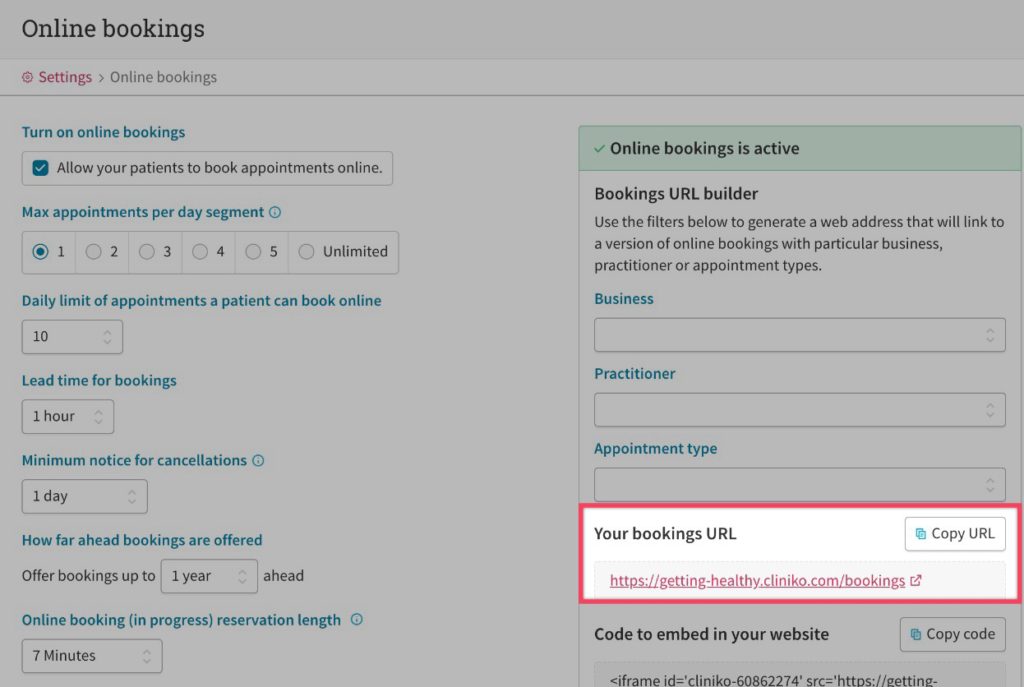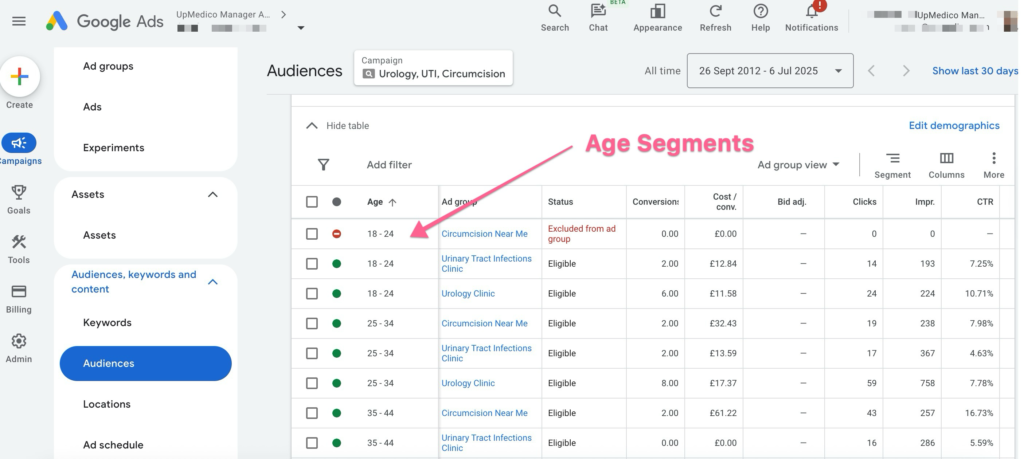Hi Director—Let’s Talk About Appointments, Not Just Ad Clicks.
If you’re managing a Google Ads campaign for your clinic, you’re likely feeling the impact of rising costs and changing search behaviours due to AI. You may be wondering:
- “Why are we spending more on Google Ads without seeing more bookings?”
- “Which campaigns are actually driving new patients?”
- “Is our data even telling the full story?”
You’re not alone. In 2025, with AI search changing how people interact with Google, and privacy restrictions limiting what platforms can track, running profitable campaigns has gotten more complex—but also more rewarding when done right.
Let’s walk through how you can future-proof your advertising strategy, avoid the most common pitfalls, and make sure every pound you spend is helping fill appointment slots—not just generate clicks.
⚠️ A Quick Warning on Google Ads Risks in 2025
Before we get into tactics, it’s important to flag the risks we see most often when working with clinics across the world:
- Incomplete Tracking = Budget Waste
If you’re not feeding Google the right conversion data (e.g., qualified leads, not just form fills), you’re optimising for the wrong actions. - Over-reliance on Platform Data
Google Ads wants to show good results, but what you see in-platform might not match actual patient outcomes. Cross-check with your practice management software. - Policy Violations
Especially in healthcare, using restricted keywords or making guarantees like “permanent results” can get your ads disapproved—or worse, your account suspended. - Attribution Confusion
If you’re running ads on multiple platforms (Meta, TikTok, Google), you’ll often see conflicting reports. Without a central source of truth, it’s hard to know what’s actually working.
Understanding the Power of Conversion Tracking
Let’s say you run a musculoskeletal clinic in South London offering physio, osteopathy, and sports injury treatments.
Your ad campaign for “osteopath near Clapham” generates 120 form fills in June. Google tells you that’s 120 conversions. But when your front desk checks your CRM, only 45 of those leads turned into actual patients.
Here’s the problem:
Google doesn’t know which of those leads actually showed up. So, unless you feed that info back into Google Ads, it will keep optimising for quantity—not quality.
Real Example from a London Clinic:
We helped one of our clients connect their booking system (Cliniko) with Google Ads, allowing only attended appointments to be marked as conversions. The result? A 32% drop in cost per actual patient over 60 days—just by teaching Google what success really looks like.
3 Smart Strategies to Maximise Bookings (Not Just Clicks)
1. Start with the Right Conversion Event
✅ Best for: Clinics with online bookings or intake forms.
- Therapy practices with intake forms
- Private GPs or allied health clinics offering online bookings
- Diagnostics providers (e.g. imaging or testing clinics) that use appointment scheduling software
Instead of tracking every form fill as a conversion, set up your funnel like this:
- Step 1: Track form fills or call clicks as initial leads
- Step 2: In your Practice Management Software (like Pabau, Semble, or Clinko), tag leads that become patients
- Step 3: Send the “qualified lead” data back into Google Ads by adding the conversion tag to the Practice Management Software’s thank-you page. Here is our example guide for Cliniko.

This tells Google which leads are valuable, so it can find more of them.
Bonus Tip: Use UTM parameters to track which keywords are driving the highest-quality leads. This lets you reduce bids on low-converting terms.
2. Layer in Demographics + Device Targeting
✅ Best for: Clinics targeting specific age or gender profiles.
- Physiotherapy and osteopathy clinics
- Aesthetic clinics targeting specific age/gender segments
- Women’s health or fertility clinics focused on a defined demographic

If you know your physio patients tend to be professionals aged 35–55 in Zones 2–4, make sure your campaigns reflect that.
- Use demographic targeting to focus on age and gender segments that convert best.
- Adjust bids for mobile devices if most bookings come from phones.
- Exclude time windows (e.g. 11pm–6am) where bookings never happen.
This precision cuts wasted spend and boosts ROI—especially helpful when budgets are tight.
3. Use Lead Qualification Questions on Your Landing Page
✅ Best for: Clinics with high call volume or limited capacity
- Specialist clinics with limited appointment slots
- Mental health services screening for clinical fit
- Surgical or high-cost treatments requiring readiness from patients
Adding a short questionnaire before your booking form (“What symptoms are you experiencing?” or “How soon do you need to be seen?”) helps pre-qualify leads and filter out poor-fit prospects.
Google’s AI uses landing page signals to determine ad quality and relevance. So if your page makes it easier for real patients to convert, your CPC drops and performance improves.
Technical Enhancements Every Clinic Should Consider in 2025
AI-Powered Campaign Optimisation
- Use Google’s Performance Max campaigns to automatically run ads across YouTube, Maps, and Gmail in addition to Search.
- Feed in high-quality conversion data (like qualified leads, not just form fills) to train the system.
Enhanced Attribution Models
- Shift to Data-Driven Attribution (DDA) in Google Ads, which gives partial credit to upper-funnel clicks—not just the last one.
- Use a practice management software like Pabau to see which sources are producing real appointments.
📞 Call Tracking Integration
- Utilise Google Call Tracking to attribute phone calls to the corresponding campaigns.
- Record call outcomes to determine if they resulted in actual bookings or just price inquiries.
Quick FAQ: What Clinic Directors Ask Us in 2025
Q: Are Google Ads still effective now that AI Overviews dominate search results?
A: Absolutely—but the strategy has shifted. With AI Overviews often appearing above organic listings, Google Ads remain the only reliable way to guarantee visibility at the top of the page. Think of SEO as your long game, and Google Ads as your short-term engine for bookings.
Q: What’s considered a healthy cost-per-lead for clinics in London?
A: It depends on your specialty and service price point, but current 2025 benchmarks are:
- Avg. CPC: £0.89–£8.20
- Avg. Cost per Qualified Lead: £6–£70
- Avg. Booking Rate from Leads: 35%–50%
💡 Pro tip: The more accurately you track which leads become patients, the better you can manage spend and scale what works.
Q: Do Google Ads really work for trust-heavy services like mental health or diagnostics?
A: Yes—with the right approach. Success in high-trust sectors relies on:
- ✅ Clear, reassuring ad copy
- ✅ Patient-focused landing pages
- ✅ Visible trust signals (accreditation badges, reviews, photos of clinicians)
- ✅ Options for low-barrier entry (e.g. “free intro call” or “consult first, commit later”)
Q: We’re short on internal resources. Can we still run effective Google Ads?
A: Definitely. Many clinic teams don’t have a dedicated marketer or analyst—and that’s okay. A healthcare marketing partner like Upmedico can:
- Handle the full setup and strategy
- Implement conversion tracking and CRM integration
- Provide monthly performance reporting and budget guidance
You stay focused on patient care—we’ll handle the pipeline.
Q: What if our leads aren’t converting into actual appointments?
A: That usually points to one of three issues:
- Tracking the wrong conversions (e.g. form fills vs. booked appointments)
- Mismatch between ad messaging and landing page content
- Poor follow-up process internally
🎯 Fixing this starts with aligning ad targeting, landing page design, and internal booking workflows—so your ads don’t just generate clicks, but real bookings.
Key Takeaways for Clinic Directors in 2025
- Google Ads still work—but only if you define what success looks like and track it properly
- Feed qualified lead data back into Google so it can optimise based on real business outcomes
- Don’t trust any one platform’s data blindly—cross-check with your CRM and patient records
- Look beyond just clicks. Focus on full-funnel performance: awareness → lead → booking → attended appointment
- Diversify your ad strategy across campaign types (Search, PMax, YouTube) to maintain growth and reduce platform fatigue
Conclusion
At Upmedico Healthcare Marketing, we can manage Google Ads for your clinic and help you leverage its full potential. Google Ads offers a powerful platform for clinics to enhance their online presence, attract more clients, and provide targeted healthcare solutions promptly.
By understanding and implementing strategic ad campaigns, and feeding Google real-world patient outcomes—not just clicks—you can not only meet but exceed the expectations of today’s digitally savvy clients.
Ready to elevate your clinic’s digital strategy?
Contact us here to connect with our experts who are dedicated to helping you attract more clients and grow your clinic. 💡
Sources:
WordStream: They provide insights into average CPC, CTR, conversion rates, and more.
Statista: Offers a range of statistics on digital marketing and sector-specific performance metrics, including beauty and wellness.
Google Ads Help: Provides extensive guidance and best practices that can help infer the performance of ads.






